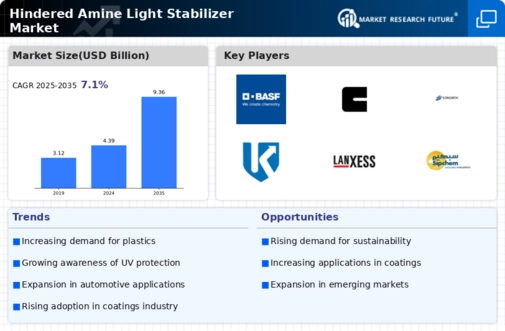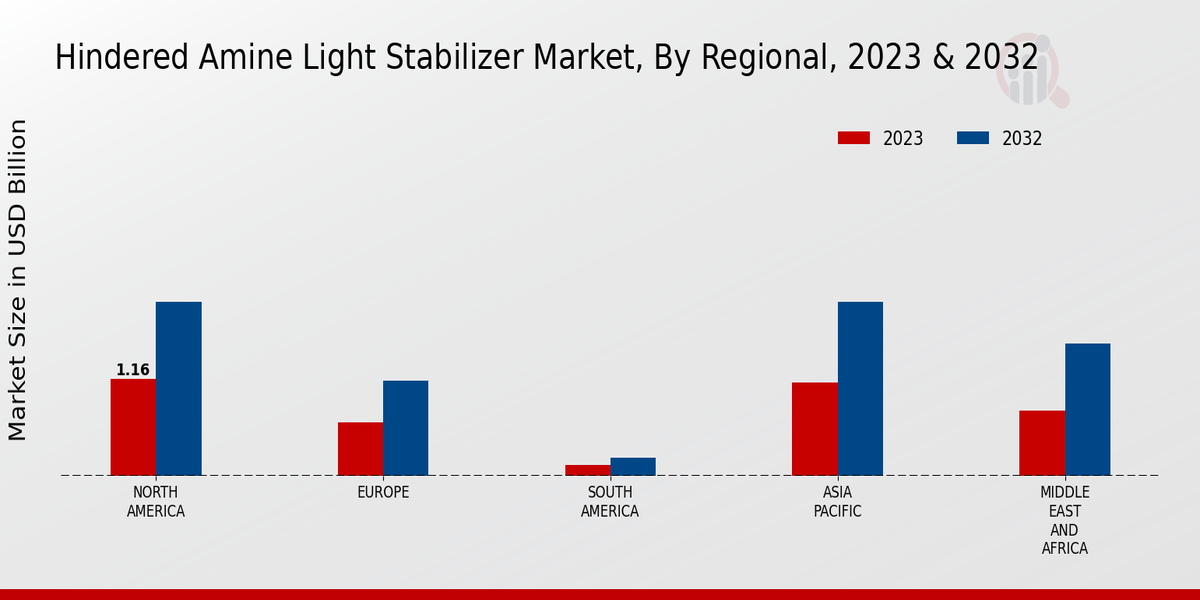Market Growth Projections
The Global Hindered Amine Light Stabilizer Market Industry is poised for substantial growth, with projections indicating a market value of 9.36 USD Billion by 2035. This growth trajectory is underpinned by a compound annual growth rate of 7.13% from 2025 to 2035, suggesting a robust demand for hindered amine light stabilizers across various applications. The increasing focus on product durability and sustainability is likely to drive innovation and investment in this sector, further enhancing its growth potential. As industries continue to prioritize high-performance materials, the market is expected to evolve, adapting to changing consumer preferences and regulatory landscapes.
Rising Awareness of Product Longevity
There is a growing awareness among consumers and manufacturers regarding the importance of product longevity, which is significantly influencing the Global Hindered Amine Light Stabilizer Market Industry. As products face increased exposure to UV radiation and environmental stressors, the demand for effective stabilizers that prolong their lifespan is escalating. Industries such as automotive and construction are particularly focused on enhancing the durability of their products, leading to a higher adoption rate of hindered amine light stabilizers. This trend is expected to contribute to the market's projected growth, with an anticipated CAGR of 7.13% from 2025 to 2035.
Growing Demand from End-User Industries
The Global Hindered Amine Light Stabilizer Market Industry is experiencing a surge in demand from various end-user sectors, particularly in plastics, coatings, and adhesives. These industries utilize hindered amine light stabilizers to enhance the durability and longevity of their products against UV degradation. For instance, the plastics sector is projected to be a major contributor to market growth, driven by the increasing production of consumer goods and packaging materials. As of 2024, the market is valued at approximately 4.39 USD Billion, indicating a robust expansion trajectory fueled by the need for high-performance materials.
Expansion of the Global Manufacturing Sector
The expansion of the global manufacturing sector is a key driver for the Global Hindered Amine Light Stabilizer Market Industry. As economies recover and industrial activities ramp up, there is an increased demand for materials that can withstand harsh environmental conditions. This trend is particularly evident in emerging markets, where rapid industrialization is taking place. The need for high-performance materials in construction, automotive, and consumer goods is driving the demand for hindered amine light stabilizers. By 2035, the market is projected to reach approximately 9.36 USD Billion, reflecting the significant role of manufacturing growth in shaping market dynamics.
Regulatory Support for Sustainable Practices
The Global Hindered Amine Light Stabilizer Market Industry benefits from increasing regulatory support aimed at promoting sustainable practices. Governments worldwide are implementing stringent regulations to minimize environmental impact, which encourages the use of eco-friendly stabilizers. This shift is particularly evident in the European Union, where policies favor the adoption of sustainable materials in manufacturing. Consequently, manufacturers are investing in the development of bio-based hindered amine light stabilizers, which are anticipated to gain traction in the market. This regulatory landscape is likely to enhance the industry's growth prospects as sustainability becomes a priority for consumers and businesses alike.
Technological Advancements in Stabilizer Production
Innovations in the production processes of hindered amine light stabilizers are propelling the Global Hindered Amine Light Stabilizer Market Industry forward. Enhanced manufacturing techniques not only improve the efficiency of stabilizers but also reduce production costs, making them more accessible to a wider range of applications. For example, advancements in polymer chemistry have led to the development of more effective stabilizers that offer superior protection against environmental stressors. This technological evolution is expected to sustain the market's growth, as manufacturers increasingly adopt these innovations to meet the rising demand for high-quality products.



















Leave a Comment